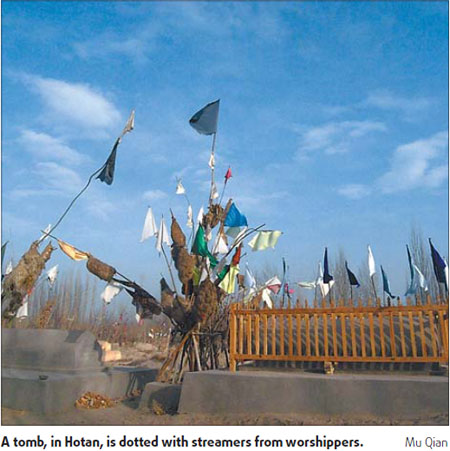
|
CHINA> Travel
 |
|
Mazar worship, a common practice for divine favors
(China Daily)
Updated: 2009-05-12 17:26
 The Uygur word "mazar" is borrowed from Arabic language. Literally meaning "a place for visit", it usually refers to the tombs of Islamic saints or famous people. Several hundred of these tombs, mythical or real, are scattered around the deserts and oases of Xinjiang, especially in the southern and eastern parts. Mazars in Xinjiang can be divided into two kinds: related or unrelated to Islam. The first kind include tombs of people who contributed to the spread of Islam in Xinjiang and the other kind includes mazars of famous scholars. Mazar worshipping is a common practice in Xinjiang. Uygur people worship mazars on certain or uncertain dates, in the hope of getting blessing for good harvests, health, the birth of children, and so on. However, worshipping mazars actually contradicts doctrines of Islam, which directs that no one is the object of worship but Allah, and asking prophets to satisfy any need or to cure any disease are polytheistic actions forbidden by Allah. Still, mazar worshipping is found not only in Xinjiang, but also in many Islamic countries, such as Pakistan, Afghanistan and Iran. Scholars believe such behavior is related to the idea of "saints" in various religions before Islam and the practice of the Shia and Sufi sects of Islam. Important mazars in Xinjiang: Sutuk Boghra Khan Mazar Sutuk Boghra Khan (?-955) is the first khan converted to Islam in Xinjiang, and his mazar, located in Artux, capital city of the Kezilesu Kirgiz autonomous prefecture, is the earliest Islamic mausoleum in Xinjiang. First built upon the khan's death, the mazar has been rebuilt many times in history, the most recent one in 1950. Now the mazar occupies an area of about 10,000 sq m, consisting of the gate, walls, courtyard and grave chamber. To the east of the mazar are a mosque, lecture room and dormitory, and to the south is an orchard of fig, grape, peach and pear. The Sutuk Boghra Khan Mazar enjoys a high reputation among Muslims in Xinjiang and Central Asian countries, and the local government has listed it as a cultural relic under key protection. Ordam Mazar The Ordam Mazar is situated in a remote desert in Kashgar prefecture, yet it is one of the most influential mazars in Xinjiang. The Ordam Mazar is the tomb of Ali Arslan Khan (?-998), a grandson of Sutuk Boghra Khan and a martyr who died leading a jihad against the Buddhist kingdom of Yutian. It is said that Ali Arslan Khan moved his palace to the battleground when fighting with Buddhists of Yutian in AD 998. On the 10th day of the Muharram month in the Islamic calendar, the Buddhists made a sneak attack and killed Ali Arslan Khan while he was praying. Since then, this date has become a festival for people to commemorate the martyr. Mahmud al-Kashghari Mazar Mahmud al-Kashgari (1008-1105) was a Uygur scholar and lexicographer of Turkic languages from Kashgar. He studied the Turkic dialects of his time and wrote in 1072 Compendium of the Language of the Turks, the first comprehensive dictionary of Turkic languages. The dictionary contains specimens of old Turkic poetry in the typical form of quatrains, representing all the principal genres: epic, pastoral, didactic, lyric and elegiac. The mazar is located 47.5 km away from the city of Kashgar, in the Upal township of Shufu county. Surrounded by trees and springs, it has become a famous tourism attraction. An ancient tree before the mazar is said to have grown from Mahmud al-Kashghari's walking stick. Parents often bring their children to visit the mazar, hoping that their children will be blessed with knowledgeable and wise minds. Imam Jaffar Sadik Mazar This mazar, located in the Minfeng county of Hotan area, is dedicated to Imam Jaffar, the 6th of the 12 imams of Shiism, although he died in AD 765 in Medina and was never in Xinjiang. Similar mazars of the other 11 imams can also be found in Hotan area. Built on a big sand hill, the mazar is dotted with numerous streamers from worshippers. Every year from August to September, Muslims from all over Xinjiang, as well as Gansu and Ningxia, come to pay pilgrimage at the mazar. |